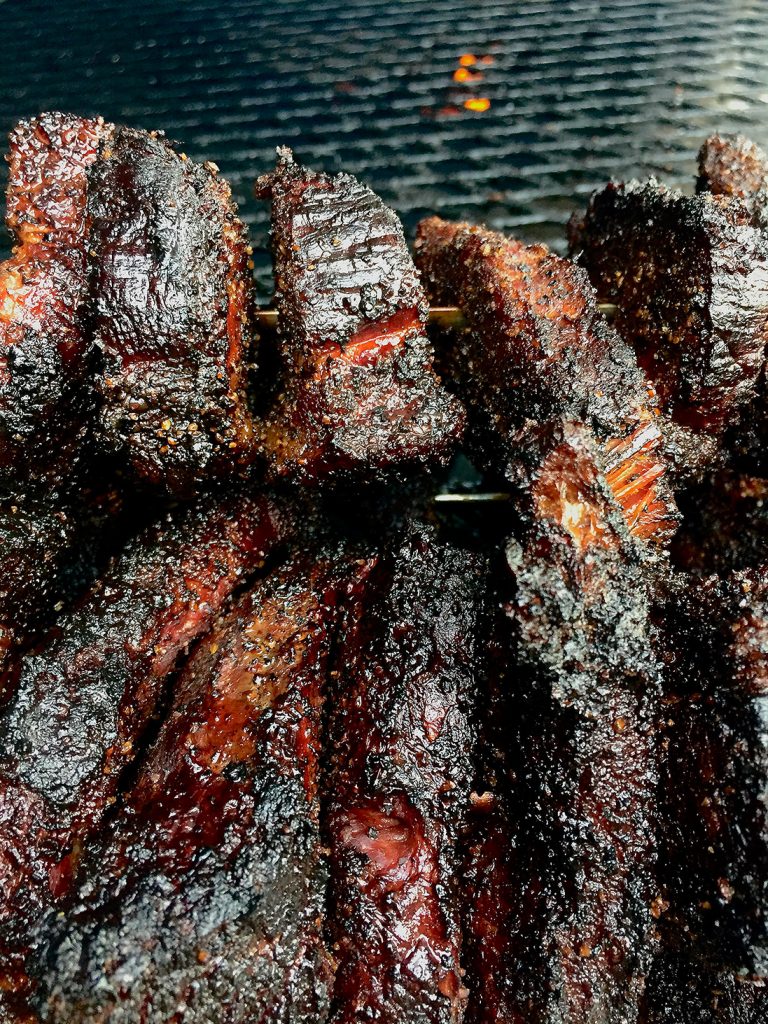
Brisket burnt ends cook on the smoker, held together by steel shish kabob rods. (Photo ©Marshall Cooper)
The first time I ever had brisket burnt ends was in 1967 at a barbecue shack on Maury Street located in the 5th ward of Houston, Texas. They cost $1 for a small brown paper sack full. They were really damn good and that’s when I fell in love with them. They were real, authentic, not sauced, you know cut straight off the ends, aka bark, of a brisket that had been cooked low and slow in a stick burner. Sonny Bryan would give them to you, but only if you asked. I would guess a whole smoked brisket would probably yield a pound or so of burnt ends if you trimmed all the bark off, which would be a true crime.
For the last few years I have worked on a recipe for smoking a pork shoulder into burnt ends on my stick burner. The idea started many years ago in 1972 when I watched a cook in Colima, Mexico making tacos al pastor next to an open fire. He had a gigantic primal cut of pork mounted on a big vertical spindle that rotated right up against a hotter-than-hell charcoal fire. As the hunk cooked he would slowly rotate the spindle, shaving off the cooked edges of the meat and make the tacos. That meat he cooked sure looked and tasted like brisket burnt ends. That’s what we call them in Texas, burnt ends. I suspect the technique I saw in Mexico may have been taken from the Greek gyro.
Subsequent to smoking whole sliced pork butts I began to experiment with cooking whole beef briskets into burnt ends. The pork ones are good, but so is the beef. I started with a 12-pound USDA Prime brisket from Costco. The thick fat was trimmed down to 1/4 inch. I cut the entire brisket (the flat and point) into 3/4 inch or so slices against the grain, the same way as if it was cooked done. No cubes. The reason to slice to 3/4 inch or so is not only will the meat cook quicker, but if it cooks too long because the slices are too thin the meat will turn into beef jerky. Then all of the slices, on both sides were lightly rubbed (so you could still see the meat) with a Central Texas rub (1/2 cup of fresh course ground black pepper, 3 tbsp. kosher salt, 1 tsp. granulated garlic). But you can use your own favorite beef rub. Go easy on salt because too much will make the meat taste like pastrami.
I don’t have a vertical spindle to mount the slices. So for the sake of saving pit space and making it easy to move the sliced pieces around on the pit, I put them on 18” stainless steel shish kabob rods, stacked loosely, to allow a bit of airflow between the slices. Four rods were used to hold all of the slices from the 12-pound brisket. The idea on the slices is to create more sides and exposure to heat and smoke. Efficiency means more burnt ends. Plus you can cook thinner slices hotter and faster and be done sooner. I think the fat cap renders and actually bastes the meat since it is sliced and stacked loosely on the rod. If anybody has a better spindle system, please holler at me.
The loaded rods were cooked on a stick burner using a mix of seasoned, well split down hickory and post oak. The fire ran clean at 250-300F for the duration of the cook which was six hours, plus or minus. The 12 pounds of slices cooked into about five pounds of absolute heaven. No sauce was used to flavor, cook or caramelize them, just plain old cooked down natural flavors from the meat, rub, fire and smoke. This same technique works really well with a pork butt, substituting your favorite pork rub. And you can brine pork. I’ve not tried lamb, which might be really good as well.

The finished product, brisket burnt ends, ready to devour. (Photo ©Marshall Cooper)







